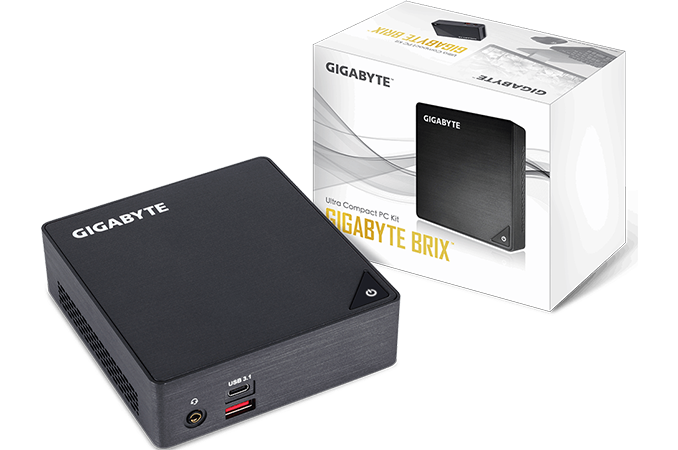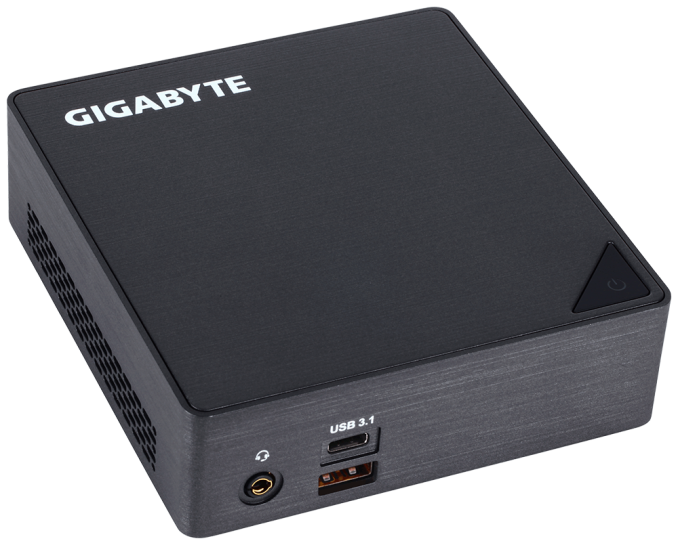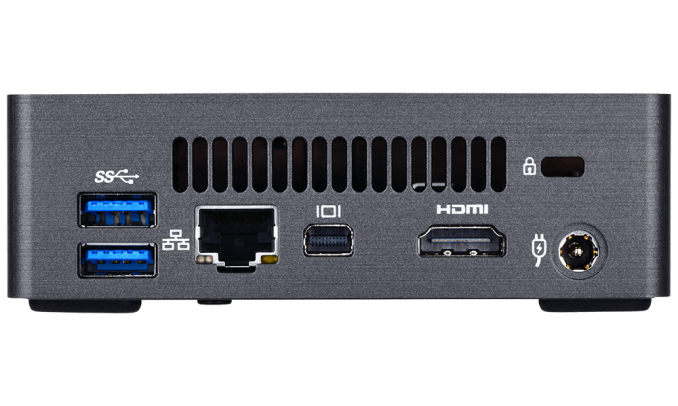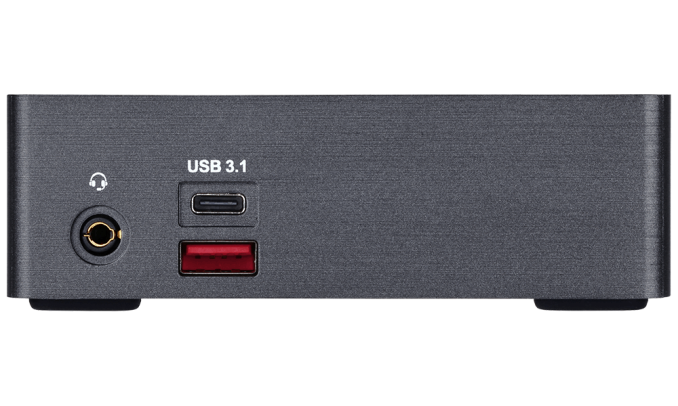GIGABYTE Updates BRIX SFF PCs with Intel’s Kaby Lake CPUs
by Anton Shilov on October 12, 2016 11:00 AM EST
GIGABYTE has updated its BRIX family of small form-factor PCs with Intel’s latest Core processors featuring the optimized Kaby Lake microarchitecture. The new systems are promoted to offer better performance than their predecessors, but are otherwise identical to BRIX PC powered by Intel’s Skylake processors: they support DDR4-2133 memory, M.2-2280 NVMe SSDs, 802.11ac Wi-Fi, USB Type-C connectors and use Intel NICs. Apart from performance, the notable improvement the new BRIX systems have are HDMI 2.0 outputs which we suspect to be via provided via an onboard LSPCON.
As Intel’s 7th generation Kaby Lake-U CPUs are drop-in compatible with motherboards supporting the Skylake-U chips, GIGABYTE uses exactly the same chassis for the new BRIX PCs featuring previous-gen processors: one is 0.46 L in volume and another is a bit larger at 0.6 L. Meanwhile, the new PCs also have better CPU and GPU performance due to higher frequency and improved architecture. Besides, the latest BRIX PCs come with HDMI 2.0 outputs, thus supporting 4K (4096×2160 pixels at 60 Hz) resolution (the HDCP 2.2 tech compulsory for certain content is supported). By contrast, the predecessors of the new BRIX systems only had HDMI 1.4b connectors (they still had mDP 1.2 ports with 4Kp60 support).
| GIGABYTE BRIX SFF PCs Based on Intel's Kaby Lake CPUs | ||||||||
| 0.6 L with 2.5-in 'HA' |
0.46 L without 2.5-in 'A' |
|||||||
| GB-BKi7HA-7500 | GB-BKi5HA-7200 | GB-BKi3HA-7100 | GB-BKi7A-7500 | GB-BKi5A-7200 | GB-BKi3A-7100 | |||
| CPU | i7-7500U 2C/4T 2.7 GHz 3.7 GHz |
i5-7200U 2C/4T 2.5 GHz 3.1 GHz |
i3-7100U 2C/4T 2.4 GHz |
i7-7500U 2C/4T 2.7 GHz 3.7 GHz |
i5-7200U 2C/4T 2.5 GHz 3.1 GHz |
i3-7100U 2C/4T 2.4 GHz |
||
| GPU | HD Graphics 620 24 EUs up to 1050 MHz |
|||||||
| RAM | 2×DDR4-2133 SO-DIMMs (up to 32 GBs) | |||||||
| SSD | Up to M.2-2280 SSDs | |||||||
| HDD | 2.5"/9.5 mm | - | ||||||
| GbE | Intel i219LM | |||||||
| Wi-Fi | Intel 3168 1×1 802.11ac + BT 4.2 (via M.2 2230 card) |
|||||||
| I/O | USB 3.1 (10 Gbps) via ASMedia ASM1142 1×USB 3.1 Type-C 1×USB 3.1 Type-A 2×USB 3.0 Type-A |
|||||||
| Video | 1×HDMI 2.0 (HDCP2.2) via LSPCon 1×DisplayPort 1.2 |
|||||||
| Audio | Realtek ALC255 (ALC3234, an ALC268 variant) TRRS and HDMI connectors |
|||||||
| Size | H: 46.8 mm W: 112.6 mm L: 119.4 mm |
H: 34.4 mm W: 112.6 mm L: 119.4mm |
||||||
| Full Specs |
GB-BKi7HA-7500 | GB-BKi5A-7200 | GB-BKi3A-7100 | GB-BKi7A-7500 | GB-BKi5HA-7200 | GB-BKi3HA-7100 | ||
The audio codec is perhaps a downside, with a laptop-class ALC255 in use, however we see an Intel NIC on board which is typically a requirement for embedded management systems. I would suspect that GIGABYTE will offer these units with vPro enabled hardware/software to specific business customers if needed.
Since GIGABYTE BRIX SFF systems are barebones, end-users or systems integrators will have to equip them with their own DDR4-2133 SO-DIMM memory, an M.2 SSD and/or a 2.5” hard drive (0.6 L BRIX PCs only). Since the computers are based on Intel’s Core i-series mobile processors in BGA packaging, they cannot be upgraded with better CPUs and GPUs. As there's no Thunderbolt 3, there's no provision for external GPUs with Kaby Lake at this time.
GIGABYTE did not announce recommended prices or release dates of the new BRIX systems, but MSRPs should be similar compared to existing SFF PCs based on Intel’s Skylake processors. As for availability, typically we see devices like this on sale in 2-4 weeks after the manufacturer lists them on their website.
Source: GIGABYTE


















28 Comments
View All Comments
asktoomuch - Wednesday, October 12, 2016 - link
I'm really looking forward for them to be available. I was planning to get a NUC6I5SYK to start playing with ESXi and VMs at home but seeing how these sports Kaby Lake CPUs, I guess I will wait a few weeks. Can't wait to see some real reviews though.TheinsanegamerN - Wednesday, October 12, 2016 - link
and sadly, no iris parts. Only intel's own NUCs seem to get it right.esterhasz - Thursday, October 13, 2016 - link
The Kaby Lakes with Iris are not out yet and Intel is not selling a KL NUC with Iris graphics.TheinsanegamerN - Thursday, October 13, 2016 - link
and how do you know intel will not make an iris NUC with kaby lake? They have dont so with every previous generation.BrokenCrayons - Thursday, October 13, 2016 - link
The implication was "not yet" as opposed to "not ever" with respect to Kaby Lake Iris parts.I'm disappointed in the lack of Iris parts available on the market, but that disappointment comes with caveats. People often use Iris as a justification for NV and AMD not producing low-end, single slot GPUs since such cards wouldn't compete with Iris. Though Iris is competitive, there aren't enough of them at enough price brackets to meaningfully replace low end GPUs AND that lack of low end GPU products forces consumers with older CPUs and lower end iGPUs to buy higher end graphics cards than they want or need (with knock-on effects of possibly buying a more expensive/larger power supply to support it). It gives the mid- to high- end GPU market a boost in sales numbers and artifically creates demand for higher end cards making the gaming industry look more vibrant and active than it really is due to all these sales...sales that only exist because consumers have no other alternative. Eventually, consumers won't want to absorb the cost and exit the PC gaming market. That's what happened to me over the past few years as product stacks and costs rise above what I'm interested in paying just to kill time. These days, I'm back to catching pokemon on my DS Lite because PC gaming isn't fun and costs too much, even for someone that's comfortably middle class. Thanks for that, Intel (AMD too for those R7 iGPUs, but at least you can buy them if you were so inclined). I'd offer to let Intel kick my puppy and pee in my cereal too if I had a dog or a bowl of cereal.
Besides that, the other problem with Iris is cooling. There's a lot of hot running transistors to cool with an Iris part and they tend to run at higher temps than I'm comfy with seeing. The recent Skylake Skull-thing NUC review here on AT made it clear that things get toasty when an Iris part is under load. I think cramming Iris into a NUC form factor means special attention has to be given to cooling and even Intel has proven with the last skull NUC that they're as incapable of doing that as the rest of the industry.
1_rick - Thursday, October 13, 2016 - link
I have one of the Skull Canyon NUCs. The most intensive gaming I do on it is Guild Wars 2 and heavily-modded Minecraft. Yes, the fan is definitely noticeable when playing that, and some pretty hot air comes out the back, but the fan noise--and I am obsessive about noise--is not actually bad if you've got sound on, and I can play for hours without the system throttling.vdidenko - Wednesday, October 12, 2016 - link
Size vs. volume data makes little sense. How come taller box has lesser volume given same foorprint?Samus - Thursday, October 13, 2016 - link
I still have my core i3 BRIX Projector. Fun little PC the kids love bringing it outside to the patio or up to their room to watch movies with friends. Obviously with it was a better than 480p projector but it works great up to 100"It's those niche pc's that gigabyte and shuttle design that make them relevant. Something like these don't even register on my radar. If I'm looking for a barebones no frills NUC I'm buying an Intel NUC.